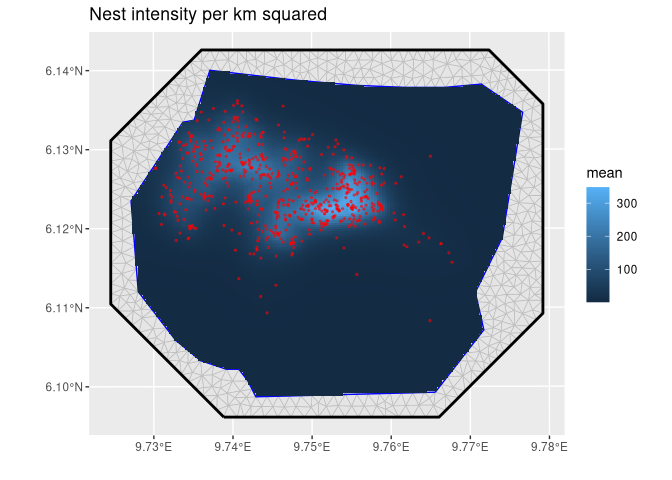The goal of inlabru is to facilitate spatial
modeling using integrated nested Laplace approximation via the R-INLA
package. Additionally, extends the GAM-like
model class to more general nonlinear predictor expressions, and
implements a log Gaussian Cox process likelihood for modeling univariate
and spatial point processes based on ecological survey data. Model
components are specified with general inputs and mapping methods to the
latent variables, and the predictors are specified via general R
expressions, with separate expressions for each observation likelihood
model in multi-likelihood models. A prediction method based on fast
Monte Carlo sampling allows posterior prediction of general expressions
of the latent variables. See Fabian E. Bachl, Finn Lindgren, David L.
Borchers, and Janine B. Illian (2019), inlabru: an R package for
Bayesian spatial modelling from ecological survey data, Methods in
Ecology and Evolution, British Ecological Society, 10, 760–766,
doi:10.1111/2041-210X.13168,
and citation("inlabru").
The inlabru.org website has links to old tutorials with code examples for versions up to 2.1.13. For later versions, updated versions of these tutorials, as well as new examples, can be found at https://inlabru-org.github.io/inlabru/articles/
You can install the current CRAN version version of inlabru:
options(repos = c(
INLA = "https://inla.r-inla-download.org/R/testing",
getOption("repos")
))
install.packages("inlabru")Installation using pak
You can install the latest bugfix release of inlabru from GitHub with:
# install.packages("pak")
pak::repo_add(INLA = "https://inla.r-inla-download.org/R/testing")
pak::pkg_install("inlabru-org/inlabru@stable")You can install the development version of inlabru from GitHub with
pak::pkg_install("inlabru-org/inlabru")or track the development version builds via inlabru-org.r-universe.dev:
# Enable universe(s) by inlabru-org
pak::repo_add(inlabruorg = "https://inlabru-org.r-universe.dev")
pak::pkg_install("inlabru")This will pick the r-universe version if it is more recent than the CRAN version.
You can install the latest bugfix release of inlabru from GitHub with:
# install.packages("remotes")
remotes::install_github("inlabru-org/inlabru", ref = "stable")You can install the development version of inlabru from GitHub with
remotes::install_github("inlabru-org/inlabru", ref = "devel")or track the development version builds via inlabru-org.r-universe.dev:
# Enable universe(s) by inlabru-org
options(repos = c(
inlabruorg = "https://inlabru-org.r-universe.dev",
INLA = "https://inla.r-inla-download.org/R/testing",
CRAN = "https://cloud.r-project.org"
))
# Install some packages
install.packages("inlabru")This is a basic example which shows how fit a simple spatial Log Gaussian Cox Process (LGCP) and predicts its intensity:
# Load libraries
library(INLA)
#> Loading required package: Matrix
#> This is INLA_24.11.17 built 2024-11-17 09:15:42 UTC.
#> - See www.r-inla.org/contact-us for how to get help.
#> - List available models/likelihoods/etc with inla.list.models()
#> - Use inla.doc(<NAME>) to access documentation
library(inlabru)
#> Loading required package: fmesher
library(fmesher)
library(ggplot2)
# Construct latent model components
matern <- inla.spde2.pcmatern(
gorillas_sf$mesh,
prior.sigma = c(0.1, 0.01),
prior.range = c(0.01, 0.01)
)
cmp <- ~ mySmooth(geometry, model = matern) + Intercept(1)
# Fit LGCP model
# This particular bru/like combination has a shortcut function lgcp() as well
fit <- bru(
cmp,
bru_obs(
formula = geometry ~ .,
family = "cp",
data = gorillas_sf$nests,
samplers = gorillas_sf$boundary,
domain = list(geometry = gorillas_sf$mesh)
),
options = list(control.inla = list(int.strategy = "eb"))
)
# Predict Gorilla nest intensity
lambda <- predict(
fit,
fm_pixels(gorillas_sf$mesh, mask = gorillas_sf$boundary),
~ exp(mySmooth + Intercept)
)# Plot the result
ggplot() +
geom_fm(data = gorillas_sf$mesh) +
gg(lambda, geom = "tile") +
gg(gorillas_sf$nests, color = "red", size = 0.5, alpha = 0.5) +
ggtitle("Nest intensity per km squared") +
xlab("") +
ylab("")